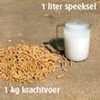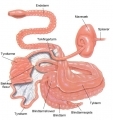From feed to energy
Horses in the wild use about 60% of their time foraging for food. Grazing is their main method of consumption. In the winter they ad bark, branches and roots to their diet. And for a short time, seasonal vegetation such as acorns, fruits and young nettles may well be a large part of their intake. In the wild a horse is used to (and built for) eating small portions, move about constantly and live from energy-poor and fiber-rich grass. To this day, the digestive system of your horse is still designed for the same process.
What happens in the body of your horse when he is eating?
In the next segment you can read everything about the gastro-intestinal tract and the digestion of nutrients.
From feed to manure
Digestion takes place between the moment when food enters the body via the mouth and the moment it leaves the body as manure. Digestion determines the energy supply of your horse. The digestive tract consists of the following components:
- Mouth
- Stomach
- Small intestine
- Appendix and large intestine (colon)
Mouth
A horse is selective when it comes to his food. With his sensitive lips the horse will tentatively explore the foodstuff and decide if it is edible or not. Your horse will be reluctant to eat items that have sharp prickles or hard parts.
Healthy teeth and molars are very important. Your horse will not be able to chew properly when his mouth hurts. Consequently, he will not be able to digest his food properly and this may cause health problems. A horse needs 40 minutes to chew 1 kg of hay. During those 40 minutes the horse produces no less than 3 to 3.5 kg of saliva. However, concentrated feed such as pellets or oats only requires 10 minutes of chewing time, and produces only 1 kg of saliva to swallow his feed.
Consequently, roughage is mixed and swallowed with much more saliva than concentrated feed.
Stomach
Horses have a relatively small stomach. This is because their ancestors ate many small portions during the day, which made a large stomach redundant. Therefore it is better to feed your horse several small portions of concentrated feed and roughage, such as 3 to 4 times per day.
We also advise letting your horse out on pasture every day, even if it is only for a short time.
Small intestine
Food passes through the stomach and into the small intestine. The small intestine predominantly digests easily digestible components such as starches, protein and fat. In the intestines, the nutrients from the food are absorbed in the bloodstream. The small intestine cannot manage a large amount of these nutrients at the same time, which is another good reason to feed the daily ration of your horse in several small portions a day.
Concentrated feed is digested primarily in the small intestine. The small intestine is also the only part of the digestive tract where vitamins, minerals (such as calcium and phosphor) and trace elements (such as zinc, copper and selenium) can be absorbed in the bloodstream. Food stays in the small intestine for about 1½ hours. Roughage such as hay, silage and grass contains mostly fibers that cannot be digested in the small intestine.
Appendix and large intestine
The large intestine absorbs water from stool and changes it from a liquid to a solid form. Compared to the small intestine, the appendix and the large intestine of the horse, where all the other feed is digested, are very large. The numerous bacteria in the large intestine digest the fibers and other remaining components of the feed. This process releases fatty acids, which can be divided in propionic acid and butyric acid and are energy sources for the horse. When the diet of a horse consists of concentrated feed only, he will get 40 to 60% of all his energy from the digestion in the large intestine. For the health of a horse it is also very important that he has a large intestine that functions well and is filled with roughage. If the large intestine would stop working, the horse could get serious complaints.




